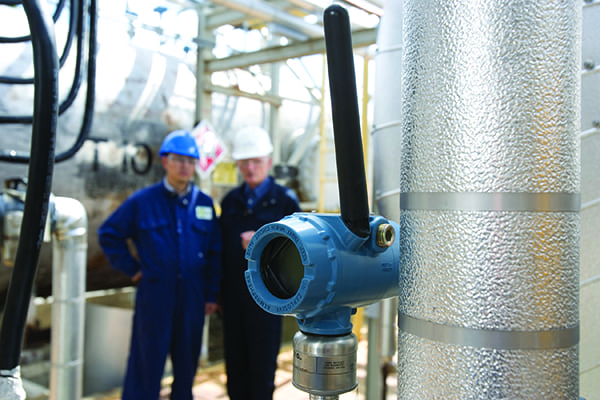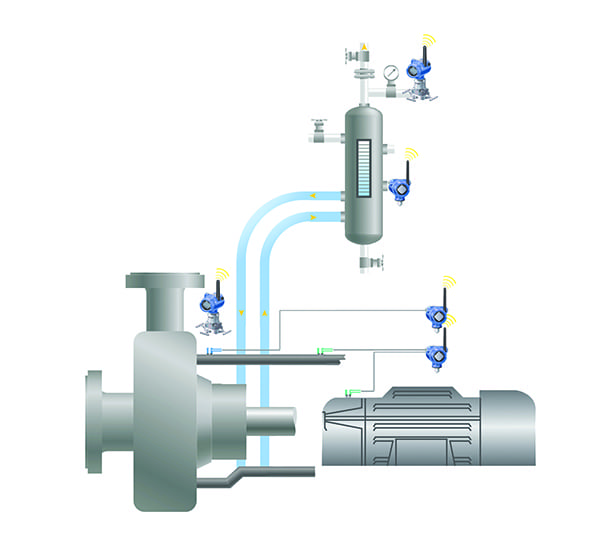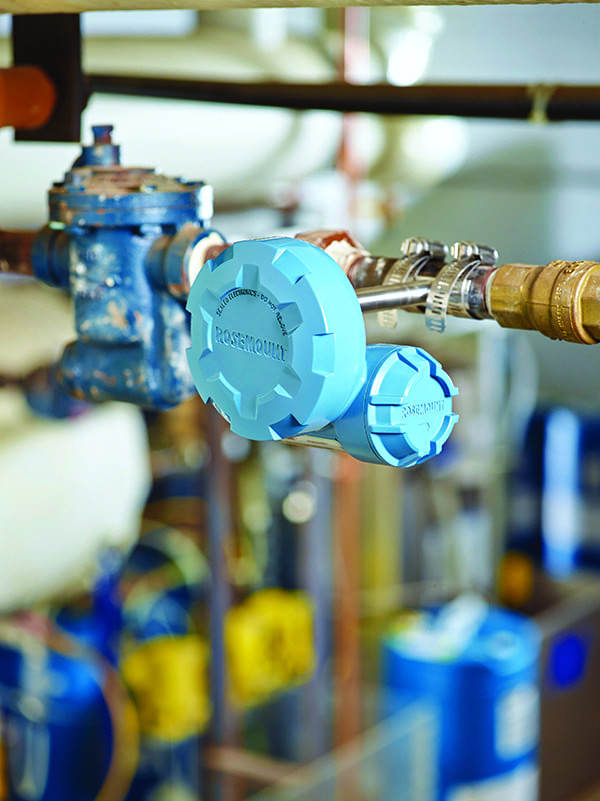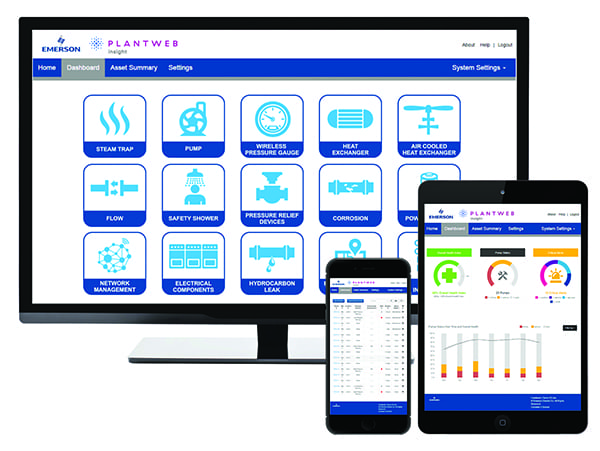How to Increase Power Plant Asset Reliability Using Modern Digital Technology
Digital tools can benefit power plants of all types, yet adding the necessary instrumentation can be costly. However, some of the latest technology doesn’t have to break the bank. Installing WirelessHART transmitters is a reliable and proven way to capture detailed operational data while avoiding the time and expense that traditional wired system retrofits entail.
Combined cycle gas turbine (CCGT) plants have become the favored technology for new power generation facilities due to the low cost of natural gas, and due to their versatility and high thermal efficiency. CCGT plants can run as baseload units, or cycle up and down to compensate for fluctuating demand and the intermittent output from renewables. As their role in the power generation landscape continues to grow, the need for reliable and efficient CCGT operation is critical.
Gas-fired units may be small in utility terms, with output typically averaging 300 MW to 550 MW, as opposed to 900 MW or more from typical coal and nuclear plants. But the smaller size hasn’t made the facilities any less complex. Most CCGT units use two gas turbines that feed their hot exhaust into a heat recovery steam generator (HRSG), powering a traditional steam turbine. As a result, all the equipment necessary to handle steam is required, such as boiler drums, condensers, pumps, and cooling towers. This leaves many places where reliability and efficiency can be gained or lost, so improvements can have a large impact, with modern digital technology often employed to realize benefits.
Keys to Improving Reliability and Availability
Most CCGT units are relatively new, but those from a few years back may have been designed with relatively light loading in mind. The move to base loading means some plants must now handle continuous operation for much longer periods. Whatever the age of a CCGT unit, there are ways to improve efficiency or reduce operating costs by deploying a few useful digital technologies.
A plant looking to improve performance and profitability should examine three key areas: reliability, availability, and heat rate. With a few basic digital technologies and applications, a CCGT can improve in all three of these areas, boosting output while reducing costs to produce greater profitability. Some areas to focus on include pumps, cooling towers, boiler drums, steam leaks, and tube fouling.
Pumps. In a typical plant, there can be dozens of pumps related to applications such as moving water and chemicals (Figure 1). The most critical, such as boiler feedwater injection pumps, will likely have continuous vibration monitoring to detect and predict bearing and seal failure, and other problems. Other pumps, often installed in critical applications, may have to depend on periodic manual vibration checks, but these installations can also benefit from continuous monitoring using digital technologies.
For example, WirelessHART transmitters make it far easier to perform continuous pump monitoring because they don’t require signal or power wiring like traditional wired instruments. Because wireless networks don’t require a wired infrastructure, a wireless transmitter can be installed for one-third to one-fifth the cost of a wired 4–20 mA or fieldbus instrument.
WirelessHART is supported by dozens of vendors and administered by the independent FieldComm Group organization. Emerson alone has installed over 30,000 WirelessHART networks, with more than 10 billion hours of operation, and installations by other vendors add greatly to these totals. This is a good example of a digital technology proven in a variety of applications around the globe, but still seen as relatively new by many end users.
A continuous pump monitoring application gathers data from these transmitters and provides analytics to detect problems at their earliest stages, such as increasing vibration noise from a motor bearing. This data can be used to predict problems before they happen, improving reliability.
Cooling Towers. Exhaust steam must be condensed, and the heat from this process is often diffused into the atmosphere using a cooling tower (Figure 2). In many locations, these are often under-instrumented installations, which results in poor control and monitoring, with fan motors a particularly problematic area.
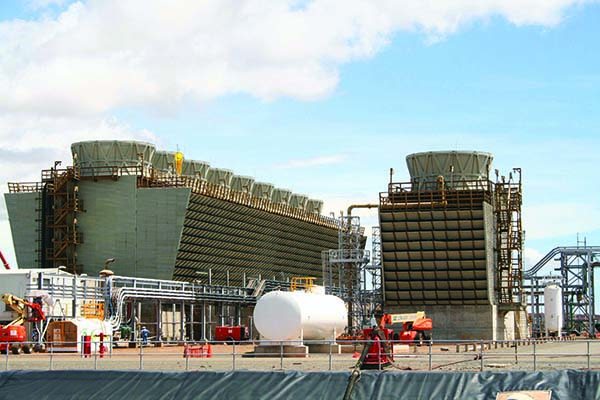 |
| 2. Condensers need cooling water. Cooling towers are frequently under-instrumented, resulting in poor maintenance and low operating efficiency. Courtesy: Emerson Automation Solutions |
The most common leading indicator of a motor failure is high vibration. As with pumps, wireless monitoring of these motors reduces the likelihood of a failure and improves availability. Emergency shutdowns due to cooling tower damage can last four to eight hours, causing a significant loss of generation output and revenue.
Boiler Drums. Maintaining a critical water level in the HRSG boiler drum has a major influence on heat rate and minimizing trips during startup, but measuring level is challenging, especially during load swings. The separation between liquid and gas is hard to define due to vapor and changing liquid density. Many of the traditional methods used to measure level do not work well.
Guided wave radar transmitters are available, and some include a digital technology specifically designed for drum level called dynamic vapor compensation. This technology reduces the level measurement error to less than 2%, even in dynamic conditions, while eliminating the maintenance problems related to traditional level measurement solutions. Data from these transmitters can be used to improve efficiency and heat rate.
Steam Leaks. The main product of the HRSG is steam to drive the turbine. Any steam lost or wasted reduces the amount of power generated, so finding and fixing leaks is critical to maintaining a sustainable and profitable heat rate. Leaking valves and poorly performing steam traps or condensate pots (Figure 3) contribute to steam loss, but these conditions might not be visible to a maintenance technician making manual rounds.
A well-seated valve is silent, whereas a leaking valve makes an identifiable noise. Similarly, a malfunctioning steam trap makes a different sound than one working correctly. Acoustic transmitters can be added to steam traps, condensate pots, and valves. The instruments listen to sounds transmitted directly through the metal. These transmitters have sophisticated digital analysis capabilities, and can recognize the sounds of bad actors and initial signs of deterioration.
Using self-powered transmitters communicating via WirelessHART is a simple way to implement a solution. Applications are available to turn the data from these acoustic transmitters into actionable information, and to send this information to maintenance and other plant personnel to warn of problems and identify which steam traps need attention, and which can be left alone.
These apps are some of the newest innovations in digital technology, using pre-built analytics with embedded domain expertise to diagnose the health of plant assets. The resulting information and insights can be accessed and visualized on a web-user interface. Dashboards and charts make navigation and interpretation of information simple, so minimal training is required. The apps include features to ensure security, including role-based access.
Tube Fouling. While natural gas produces relatively little air pollution, many plants have a NOx abatement system using gaseous ammonia injection and selective catalytic reduction. Ammonia reacts with any sulfur compounds brought in with the gas to form ammonia sulfate, which deposits on the tube bundles as a solid, reducing heat recovery. The tubes can be cleaned, but it is difficult for operators to know where and how heavy the deposits are.
The extent and location of tube fouling can be determined by measuring air flow through the HRSG, stage by stage, using differential pressure transmitters. If the unit has been cleaned, it is easy to establish a baseline for airflow. If the flow begins to get blocked, it will be detected. This information can also be used in conjunction with any falloff in heat rate caused by the insulating character of the ammonia sulfate.
Turn Data into Actionable Information
Adding more instrumentation produces a lot of data, and turning data into actionable information takes sophisticated analytical tools. A plant-wide digital network brings all this data to one place, serving up valuable information necessary to improve operations.
Analytics can find the cause-and-effect relationships driving plant performance by watching key performance indicators and answering critical questions capable of moving the needle in the right direction (Figure 4). How much will reliability improve if you monitor a larger population of pumps? Can you reduce ammonia use and still get emissions below the limit? Last month you had two weeks of exceptional performance. How can you get that all the time? Transmitters combined with digital networks and data analytics help process experts get answers to these and other questions quickly and with minimal effort.
This connectivity, data collection, and analysis provide fulfillment of the digital plant’s promise, allowing managers and operators to view actionable information in real-time from any part of the operation. ■
—Juan Panama is an engineer with Emerson Automation Solutions.
